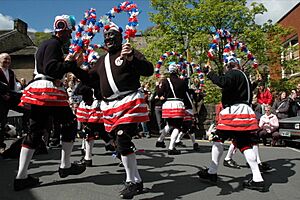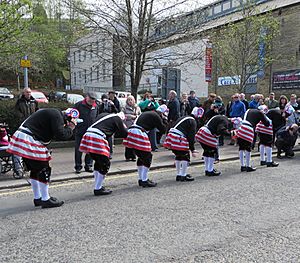Britannia Coconut Dancers facts for kids
The Britannia Coconut Dancers are a group of Lancastrian clog dancers. They are also known as the Nutters. Every Easter, they perform a special dance. They dance about 7 miles across the town of Bacup and nearby areas. Before dancing, they blacken their faces. This tradition is seen as offensive and racist by some, which makes the group controversial. There are eight dancers and a "whipper-in" who helps control the performance.
Contents
History of the Nutters
Some people believe this dancing tradition came from Moors who settled in Cornwall in the 1600s. They became miners and later moved to Lancashire to work in quarries. Similar dances are found in other parts of the world, like the "Dança do Coco" in Brazil and the "Danse des Coco" in France.
The Britannia Coconut Dancers group started in 1857. Back then, they were called the Tunstead Mill Nutters. They were one of five similar groups in the Rossendale Valley. A man named Abraham Spencer helped start the group when he was only 15 years old. In the 1920s, they passed their traditions to workers at the Britannia Mill.
Their dances often include floral hoops or garlands. Music for their dances comes from a concertina or the Stacksteads Silver Band.
What They Wear
The group's name, "Coconut Dancers," comes from the wooden "nuts" they wear. These nuts are made from the tops of old bobbins. They wear them at their knees, waists, and wrists. These nuts were originally protective gear for miners. Miners used them when crawling in tight spaces. The nut at the waist is a spare, in case others break or get lost.
The dancers tap these wooden nuts together. They make a rhythmic sound like castanets. The nuts on their hands hit the nuts on their waists or knees. This creates a complex and skillful beat.
Their costume also includes white turbans with blue feathers. They wear dark jerseys (shirts) and trews (trousers). They have a white baldric (a belt worn over one shoulder). They also wear red and white skirts, white hose (stockings), and black clogs.
The Blackened Faces
The dancers blacken their faces for performances. There are different ideas about why they do this. Some say it's because of the dance's origins in mining communities. Others believe it refers to ancient Barbary pirates. Another idea is that it's a disguise to keep away evil spirits.
However, research suggests the tradition might have come from minstrel shows. These were performances where white people often darkened their faces. Over time, the dancers have shared other stories about their tradition. These stories do not include the connection to minstrelsy.
This practice caused some debate in 2014. A local politician, Will Straw, was photographed with the group. He defended the custom. He said that old traditions help communities feel connected.
Who Are the Members?
The Britannia Coconut Dancers have members who have been part of the group for a long time. Dick Shufflebottom, for example, danced for over 50 years. In 2006, his 50 years of service were celebrated. He was still dancing actively in 2013, at 76 years old. At that time, the youngest member was Gavin McNulty, who was 26.
Their Performances
The main performance of the year is on Easter Saturday. However, the group practices every week throughout the year. These rehearsals are also a social event for the members.
In 2013, the annual Easter performance faced a challenge. The police and local government said they might not be able to help with traffic control and security. This was due to cuts in public spending.
What People Think
A writer named AA Gill described the dancers as strangely captivating. He wrote that the dance starts with each dancer listening closely. Then they point a finger at each other and begin. They stomp and move in circles. Sometimes they hold bent sticks covered with red, white, and blue ribbons. They weave these into simple patterns.
He said the dance is not pretty or clever. Instead, he called it "awe-inspiringly, astonishingly other." He noted that even Morris dancers from other parts of England come to watch them. He felt that nothing else in the world is quite as unique and strangely powerful as the Bacup Coconutters.
Recordings of the Dancers
A five-minute black-and-white film of the dancers was made in 1930. It has new music and is part of a DVD called Here's a Health to the Barley Mow. The BFI released this DVD in 2011.
A short music recording of their dance was made in 1972. It is on an album called The Voice of the People, Volume 16: You Lazy Lot of Bone Shakers – Songs & Dance Tunes of Seasonal Events. Topic Records released this album. This recording was also included in Topic's 70-year anniversary box set, Three Score and Ten.
See also
- Garland dance
- Molly dance
- Saddleworth Morris Men




